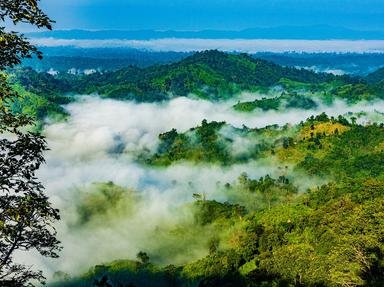Quiz Answer Key and Fun Facts
1. The endangered Bengal tiger calls the UNESCO World Heritage Site the Sundarbans home. What exactly are the Sundarbans?
2. Although Bangladesh is a mainly Muslim country, the next UNESCO World Heritage Site is the ruins of a monastery that belonged to which religion?
3. This UNESCO World Heritage Site is related to its Muslim heritage. The Historic Mosque City of Bagerhat is situated at the meeting place of the Brahmaputra River and what other 'sacred' river that begins in the Himalayas in India, before emptying into the Bay of Bengal in Bangladesh?
4. The capital, Dhaka, is considered by most to be named after Bangladesh's national temple, Dhakeshwari National Temple, a temple that one might expect to find in India more than Bangladesh. What religion is this temple?
5. One of the longest sandy beaches in the world is located at Cox's Bazar. In which administrative division of Bangladesh, that shares its name with the second largest city in the country, is Cox's Bazar located?
6. The Barisal Division of Bangladesh was once called the "Crop house of Bengal" because of its production of which crop that is still a main staple of the country and an important part of its economy?
7. Khulna City in the Khulna Division is a major exporter of which decapod crustacean that would probably make it the envy of Forrest Gump?
8. The city of Rajshahi is an important center in the production of a natural fiber that comes from a certain worm. What is the nickname of the city that comes from this association?
9. The city of Sylhet and the Sylhet Division of Bangladesh are important parts of which beverage industry that was an important part of the British Empire and still is an important part of every day life in Britain?
10. The name of this city in Bangladesh shares its name with a citrus fruit, also known as a lemandarin, and is located in northwestern part of the country. Which city is this?
Source: Author
tazman6619
This quiz was reviewed by FunTrivia editor
Tizzabelle before going online.
Any errors found in FunTrivia content are routinely corrected through our feedback system.

